
|
|
13 November, 1999
Saturday November 13, 1999
After "dining" it was time to investigate the opposition's camp. Some how
they managed to scoff two Scott tens and were told to build a snow trench
instead of a snow mound. A snow trench is exactly what the name says. It is
a trenched cut out to the snow; it is just a bit wider then the sleeping bag
and blocks of snow are placed over it in the fashion of an A-framed house.
It was really quiet nice and very well constructed. One thing about both
the trench and, the snow mound and the snow wall is when the sun strikes the
edges of the blocks of snow that makes these up they have a beautiful blue
color to them.
It was probably about 1800 hour on last night (11/12/99) when a bunch of us
decide to walk the flagged trail. The trail actually becomes part of the
Castle Rock loop, a 7-mile trek over glacier, ice sheet and sea ice. We
walked probably 1.5 miles out to the face of a glacier. The blue ice of the
glacier showed magnificently against the light snow that clung to the spots
where the wind did not hit. I guess the glacier face has to be around 200
feet tall. This is in an area known as "Silver Junction". No idea why.
While we were there the wind started to whip and you could see a whiteout
approaching from the south. A whiteout is where the blowing snow eliminates
all visibility. Some of us hustled back toward camp, while others opted to
wait in a small hut that had been erected at Silver City and it hit just
after we arrived. We stayed behind the snow wall and were well protected.
The squall left as quickly as it had come. We cranked up the stoves and mad
e hot soup and chocolate and cider and we ate some more. Got to stoke the
furnace before you go to bed. I n fact were advised to tae a couple of
chocolate bars to bed with us. Two Kiwis in the tent next to me went to bed
first. Then I decided to turn in. My "roommate" Bert stayed out on the
trail.
"Yellow Flag' time (a unique experience to say the least) and then to bed.
Ya right! First I placed boiling water in my water bottle and put it into
the liner of my sleeping bag, which after much struggling I finally got to
lay out, sort of flat, in my sleeping bag. Keep in mind I am on my hands
and knee bent over into the tent. The wind is blowing, so as soon as I
finished that, I tried to brush/blow the snow that had blown into the tent
out of the tent. I buttoned up the tent and had to stand to catch my
breath. Working with all that gear on is most difficult. I took a break,
drank more chocolate and ate some more trail mix. Now back to bed. I
crawled into the tent and as my feet passed through the vestibule, I turned,
sat up and took off my bunny boot, put them inside the tent door and
buttoned it up. Now sitting there, what to do next? I decided to take off
my parka and to sleep with the rest of my gear on. From outside to inside
layer: polar fleece jacket, wind bibs coveralls, polar fleece coverall,
insulated pants and shirt and then me. Oh ya, I slept with my hat on too.
Now, to turn and to get into this sleeping bag with its liner was another
challenge. Gradually I worked my way down into the bag, but not without much
twisting, turning and an inordinate amount of grunting. I was getting
exhausted just going to bed. Unbelievable! Now I needed a drink, but of
course my water bottle was full of boiling water. Oh well, I'll survive.
Besides, if I drink I might have to do the "yellow flag shuffle" and
thoughts of getting out of the bag, and then getting dressed, and then
getting out of the tent and then shuffling off to the "yellow flag" through
the blowing snow were just more then I could bear. I put the parka at the
top of the sleeping bag and used it for a pillow. Ah, ready to sleep at
last. Well not quite! It's about this concept of zippering a sleeping bag
that has a liner and you with all your gear on in it. After about 15 minutes
of struggling I decided to leave the bag about 1/3 unzipped. Ready for
sleep at last.
Finally feel asleep, I don't know how much later, only to be awakened by
Bert trying to get into the tent. I thought I had problems, I am only 5'
31/2", Bert is over 6'4". It was a bit comical. He is so long that he had
to sleep with his head in the vestibule. For once it's good to be short.
We evidently fell asleep but at about 0400 hours Natured called and I awoke.
Getting out of the bag, dressed and closing the tent was not an easy task
although Bert was cutting big time ZZZ's. (I learned later that I
evidently, my snoring actually, was responsible for more lost sleep then the
cold weather. Ooops, sorry.)
The journey to the outhouse was beautiful, but unique. The outhouse even
more so, unique that is. Suffice it to say the seat is styrofoam so you
literally do not freeze to it. Rather then disturbing Bert by trying to get
back into my sleeping bag, and everyone else too, I went for a short walk
out on the flagged route toward Silver City. Once again thoughts drifted
back to home only this time on a more positive note I was wishing that the
kids and Darcy could be afforded an opportunity to do what I am doing. I'm
really not too sure all the kids would enjoy it, the boys yes, the girls,
that's another story. I could probably bank on Darcy not enjoying it, she
has a tough enough time dealing with the relatively cool weather we have at
home. Nonetheless, it sure would be nice just to hold her hand and stroll
across the ice sheet. Oh well.
I returned to camp and started boiling some water for our breakfast. The
bulk of the gang got up around 0615 hours. We all ate and had the camp
struck by 0900 hours, the time when Chas was to return with the Nod-well to
pick us up. Chas, who had spent the night sleeping in the snow trench that
the opposition team had built, drove the Nod-well up right on time. We
loaded her up and were instructed to walk to the instructors hut. Upon
arrival there was more food to eat and more lessons to learn. We putzed for
a while waiting for Bill McCormick, the senior survival school instructor,
to show up. Once he did we were given instructions on how to use the
hand-held radios and the VHF radios such as the ones we'll use in the dry
valleys. It was a bit nerve racking for the KIWI troops knew all this
stuff and some of us, who will be using this gear, wanted to learn.
After about an hour later the opposition team was taken outside with all
their ECW gear and left for somewhere with Bill. We were left behind with
Chas who told us we had a scenario to play out. It went like this: Tony,
one of the Kiwi's had gone to the outhouse about an hour ago and he was just
realized to be missing, and the weather state was a condition #1, a complete
whiteout. We had to organize a search for Tony.
Initially we were lost as to what to do. We eventually made suggestions
such as tying us at 10-meter intervals to a rope (had about a 100' rope) and
then beginning a search. Sweeping first the left-hand quadrant at the back
of the building, which was closest to the outhouse. If that did not work
we'd sweep the other side and if that did not turn Tony up, we'd do the same
thing at the front end of the building. So that was our solution. Wrong,
we had to do it. We were told to put on all our ECW gear and to search. No
problem it wasn't really a whiteout. OOPS. We had to put white buckets,
literally preventing you from seeing beyond your nose, over our head. We
found Tony, actually I did. I was the third person on the rope, so he was
about 30 meters from the Jamesway. The only problem now was that the signal
of 4 tugs on the rope to retrieve the person was not acted upon. So we did
find him, but he probably would have died from exposure. We came in and
debriefed. You could sense the realization that this in fact could, and in
fact, has happened many time before in Antarctica, and unfortunately will
probably happen again. Just as a point for those of you who remember the
Massachusetts "Blizzard of 1978" there was a young boy, from southeast
Massachusetts, who during the height of the blizzard went out to look for
his dog and never came back. All the searching, was to no avail, he lost
his life, and obviously his way to home and shelter, 7 feet from his front
porch. Whiteouts are truly unbelievable.
We thought we were done,but, we were wrong again. Bill showed up just as we
finished. We traded places with the other team and were given a new
scenario to playout. This time it was a timed thing. The Nod-well was to
be on fire and we had three goals: set up a tent, start a stove and contact
McMurdo Operations. The key though is that we had to beat the other teams
time of 8 minutes and 10 seconds.
Bill drove in circles and finally stopped; he ran to the back of the
Nod-well and announced a fire. We were wiser this time, for by the time we
exited the Nod-well we had three teams established, each with the task of
meeting a specific goal. I was on the radio team with Bert, Kyle, and one
of the KIWIs, Rodney I think. We ran to the radio box and set up the
antenna only to find that our opposition had switched all the settings and
had hid the handset. We slowed for a second, thought about we had to do;
got everything squared away and made contact with McMurdo Operations.
Having done our job, we ran to assist the tent team. We finished the whole
scenario in just 5 minutes flat. Great, but one of the dead man stakes did
not survive Mike's pull test, so we had to replant it. Done again, this
time it passed, and were were done in 7.03 minutes. We beat them in spite
of their cheating. Just as a point of information, the bad guys got their
pay back for until some one on the team cheated (again), no one could find
the victim.
Myself and two of the others were invited to ride back with Bill in a
different tracked vehicle this one was called a Sprite. It was much
quicker and much more personal, we were right in the cab with Bill. We
chatted on the way back and we learned that we had many common friends in
either NSF or ASA.
We got back to McTown about 20 minutes before the Nod-well so had time to
use the indoor plumbing. Ah yes, the things we take for granted! After
debriefing all the KIWIs and the ASA people left and the grantees remained
for a relatively short, but most important video and talk on helicopter
safety.
There are two types of copters used here, the most numerous being the A-star
and there is one (forgot the name) that is quit a bit larger. We were
instructed always to approach the bird from the front and side, never the
back; and to "hold onto your hat and if it blows off don't chase it, for you
probably won't have a head to put it on." Gruesome thought, but a real
possibility.
We were given instructions on seat belting, how to use the radio and where
the emergency beacons are located. Too much too fast, for a group of people
who just spent 2 days in deep-field and were now sitting in a hot room. (Gee
I hope I remember all this when I fly to the Dry Valleys.) We finished up
and dragged our bags back to our dorms.
I showered and had a horrible chill, so layered up and laid down. There was
a big party tonight and the whole town would be there. I planned to catch a
couple of hour of sleep. Wrong, at 0222 hours I woke up. Missed the party
and 1/2 the night, but more importantly was still shivering. I got out of
bed to put more clothes on and learned that I was not sick, but that the
furnace had gone out and it was the noise of them repairing that had
awakened me.
Till tomorrow,
Penguin Pete at Mc Station . OUT. (Do you like the radio jargon? Impressive
Hey. The Hey is KWIWI talk, these guys are truly a bad influence.)
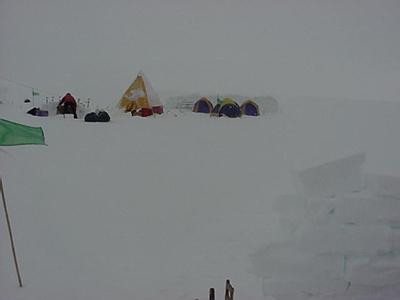
This is a picture of the Bad Guys camp. The residents of this camp, except for the one you see in front, I'm sure were planning their unspeakable acts of sabotage for our survival scenarios. However, as you'' see when you read the journal, the Good Guys (us) come out on top. Photo by Peter M. Amati, Jr. <>
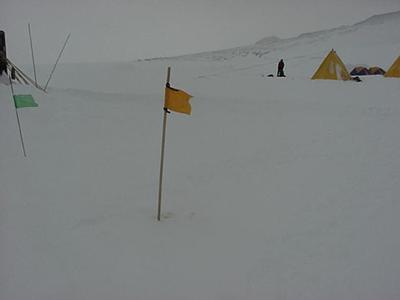
The infamous "Yellow Flag" AKA "Men's Room" at Snow Mound Base Camp USAP survival training site. Photo by Peter M. Amati, Jr. <>

"Ladies Room" (et.op.) at Snow Mound Survival Camp. Check out the 1/2 moon on the door. Under stressful conditions humor is critical. Photo by Peter M. Amati, Jr. <>
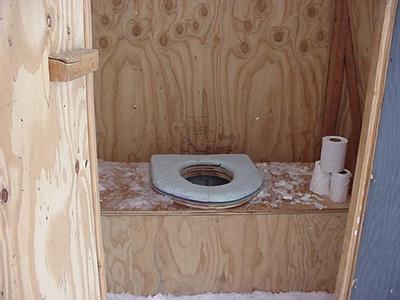
Snow Mound Camp inside view of outhouse. Notice the styrofoam seat so you don't freeze to the potty. Look closely at the ice build up on the seat. Photo by Peter M. Amati, Jr. <>

This is a view of the Ross Ice Sheet from Snow Mound Survival Camp. Photo by Peter M. Amati, Jr. <>
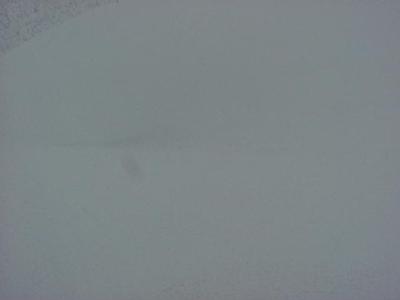
This is the same picture as the previous one, except this is during a whiteout. There was no difference here, then when they put the bucket simulating a whiteout over our heads. Photo by Peter M. Amati, Jr. <>

Here is our survival team learning how to use the VFH radio. We actually had a young lady from Spain call the Italian Camp at Terra Nova and speak to them in a cross between Spanish, Italian and English. It was just too much fun. Photo by Peter M. Amati, Jr. <>
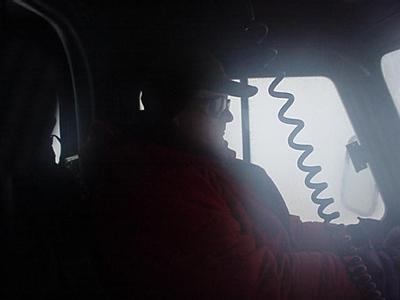
This is Bill McCormick driving us back from Snow Mound Survival Camp. Mike is the senior survival trainer and field rescue person at McMurdo Station, Antarctica. Photo by Peter M. Amati, Jr. <>
Contact the TEA in the field at
.
If you cannot connect through your browser, copy the
TEA's e-mail address in the "To:" line of
your favorite e-mail package.
|
